New General for Russia in Ukraine Portends Difficult Winter
Ukrainian sources report that Russia has now rotated the head of the Western Group of Forces four times since February.

As Ukrainians greeted the new year by dealing with a fresh barrage of Russian missiles and drones, Russia replaced the general overseeing much of its floundering invasion — portending a difficult winter for the region.
Out after only three months as commander of Russia’s Western Group is Sergei Kuzovlev; his replacement is the general who early on in the war led Moscow’s botched offensive on Kyiv, Yevgeny Nikiforov. This could play to Ukraine’s advantage, but it’s also one that underlines how Russia is in no mood for retreat.
While not explicitly stated in the Russian press, it is unlikely that the appointment of General Nikiforov could have been effected without the approval of Vladimir Putin or the Russian president’s defense minister, Sergei Shoigu. Mr. Nikiforov can be credited, if that is the word, for having attempted to capture Kyiv by shunting Russian troops and airborne forces through Chernobyl first.
According to some reports it was another general, Sergi Surovikin, the so-called butcher of Syria, who was being replaced, but that appears to not be the case. Still, the “continued churn of senior Russian officers,” the British ministry of defense stated, “probably reflects internal divisions regarding the Russian Ministry of Defense’s future conduct of the war.”
Ukrainian sources report that Russia has now rotated the head of the WGF four times since February. Noteworthy, however, was Mr. Putin’s statement in his New Year’s address that “today we are fighting for this moral, historical rightness, protecting our people in our own historical territories, in the new constituent entities of the Russian Federation.” In other words, despite all international condemnations of the Russian invasion of Ukraine and the many sanctions, the Kremlin is doubling down.
President Zelensky, for his part, said in a New Year’s video address that “fear has engulfed Russia … they are rightly worried, because they will lose,” adding that during the first night of the year, Ukraine downed 40 Iranian-made Shahed drones that Russia launched against multiple Ukrainian cities.
British intelligence assesses that General Nikiforov will be tasked with holding Russia’s right flank, in the Donbas region, which is more specifically the area of Luhansk in the vicinity of Kremina and Svatove.
As the first week of the new year began, Britain’s defense ministry stated that Russian and Ukrainian forces were battling for control of the P66 highway, which is north of Kremina, a town currently held by Russian forces. That highway is a key supply route for the northern section of Russia’s Donbas front” from Russia’s Belgorod region.
This is where things will heat up even as deep winter sets in. While Ukrainian forces are trying to wrest back control of that highway on the ground, they are making inroads on Belgorod itself, albeit from a distance. Ukrainian shelling triggered Russian air defenses at Belgorod on New Year’s eve, and a number of fires were reported in the city. Ukrainian drones have also reportedly been launched against power facility targets in the Russian regions of Bryansk, Belgorod, and Voronezh.
So far, though, Russian drone strikes against targets in Ukraine have been more numerous and damaging, particularly to the electrical infrastructure as Mr. Putin seems hellbent on making Ukrainians shiver through the harsh winter. Rockets are still very much in the Russian arsenal, too: On New Year’s Eve multiple blasts shook Kyiv, killing one person and wounding several more. Ukraine’s foreign minister, Dmytro Kuleba, said that Russian missile attacks were “deliberately targeting residential areas, not even the energy infrastructure.”
By January 2, it was back to drones, at least in the capital. Kyiv’s mayor, Vitali Klitschko, said that Russian attacks involving 40 exploding drones caused emergency power outages in at least part of the capital, despite all of them reportedly being shot down.
Russia continued its attacks across the country, mostly by aerial bombardment. Ukrainian forces shot down seven drones over the southern Mykolaiv region, and destroyed a missile over the Dnipropetrovsk region. In the southern Kherson region, five people were reportedly wounded by Russian shelling on Monday morning.
It is in the Donbas where most of the frontline fighting is happening, with casualties among soldiers of both sides difficult to corroborate. Russian media reported on Monday morning that more than 15 Ukrainian soldiers were killed in Donetsk in the previous 24 hours. At the same time, Ukraine’s general staff reported that Ukrainian forces had repelled Russian attacks near 11 settlements in Donetsk and Luhansk.
Against the backdrop of intensifying drone strikes and counter-strikes and brutal trench-style fighting in the Donbas, it is little wonder that few have any hope of an end to hostilities in the near future. As to whether 2023 will see a ceasefire in what the Financial Times calls Russia’s “calamitous gamble” in Ukraine, the answer the newspaper provided was a terse “no.”
It is more nuanced than that, of course, but the pessimism is by no means unique. According to the Guardian newspaper, “it is impossible to imagine a handshake between Volodymr Zelensky and Vladimir Putin on a negotiated peace after 10 months of war.”

